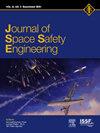有效处置月球表面的低轨道飞行器
IF 1.7
Q3 ENGINEERING, AEROSPACE
引用次数: 0
摘要
为探索月球航天器在月球表面安全有效的报废处理策略,进行了数值模拟。分析了三种不同的近极地、低空和近圆形轨道类型的处置,以确定是否可以在低燃料成本的情况下,利用月球的非球形重力场,始终实现对月球表面受保护区域风险最小化的撞击位置。利用高保真月球轨迹模型,共传播了30万个逆行处置燃烧后的物体,并将处置燃烧的位置和震级与由此产生的衰变可能性和月球表面撞击位置进行了比较。结果确定了处理策略,可以在安全地点以10米/秒的速度(ΔV或更低)对所有轨道类型产生影响,远低于将近月轨道完全降低到月球表面的ΔV成本。类似的基于模拟的方法可应用于运行中的月球卫星,以确定基于特定任务条件的处置策略。这项研究的结果支持制定安全有效的报废处置策略,最大限度地减少月球轨道上碎片的积累,延长月球任务的运行寿命。本文章由计算机程序翻译,如有差异,请以英文原文为准。
Efficient disposal of low lunar orbiters on the lunar surface
Realistic numerical simulations are conducted to explore safe and efficient strategies for End-of-Life lunar spacecraft disposal on the lunar surface. Disposal from three different near-polar, low-altitude, and near-circular orbit types was analyzed to determine if impact locations that minimize the risk to protected regions of the lunar surface can be achieved consistently for low fuel costs using the Moon’s non-spherical gravity field. A total of 300,000 objects were propagated following retrograde disposal burns using a high-fidelity lunar trajectory model, and the disposal burn locations and magnitudes were compared against the resulting likelihoods of decay and lunar surface impact locations. The results identified disposal strategies that could achieve impact in safe locations for 10 m/s of or less for all orbit types, much lower than the cost to lower the perilune entirely to the lunar surface. A similar simulation-based methodology could be applied to operational lunar satellites to identify disposal strategies based on specific mission conditions. The results of this study support the development of safe and efficient End-of-Life disposal strategies that minimize the accumulation of debris in lunar orbit and extend the operational lifetimes of lunar missions.
求助全文
通过发布文献求助,成功后即可免费获取论文全文。
去求助
来源期刊

Journal of Space Safety Engineering
Engineering-Safety, Risk, Reliability and Quality
CiteScore
2.50
自引率
0.00%
发文量
80
 求助内容:
求助内容: 应助结果提醒方式:
应助结果提醒方式:


